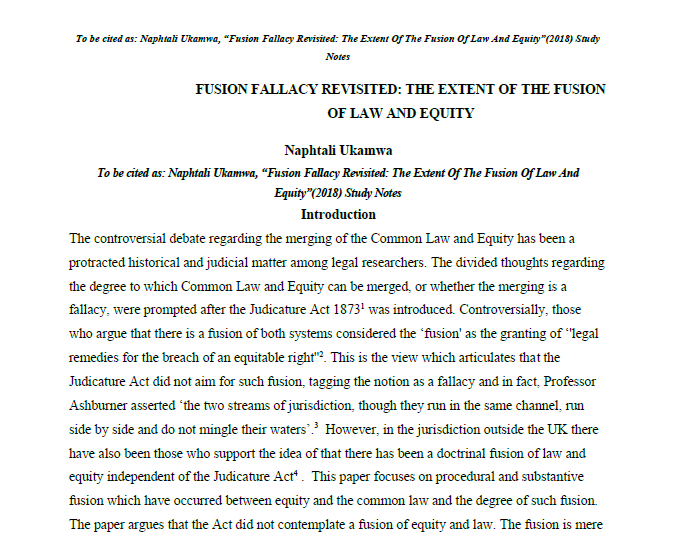LAW306A Equity Controversially University of Auckland

University of Auckland
LAW306A Equity Controversially University of Auckland
FUSION FALLACY REVISITED: THE EXTENT OF THE FUSION
OF LAW AND EQUITY
Naphtali Ukamwa
To be cited as: Naphtali Ukamwa, “Fusion Fallacy Revisited: The Extent Of The Fusion Of Law And
Equity”(2018) Study Notes
Introduction
The controversial debate regarding the merging of the Common Law and Equity has been a
protracted historical and judicial matter among legal researchers. The divided thoughts regarding
the degree to which Common Law and Equity can be merged, or whether the merging is a
fallacy, were prompted after the Judicature Act 18731 was introduced. Controversially, those
who argue that there is a fusion of both systems considered the ‘fusion’ as the granting of ‘’legal
remedies for the breach of an equitable right”2. This is the view which articulates that the
Judicature Act did not aim for such fusion, tagging the notion as a fallacy and in fact, Professor
Ashburner asserted ‘the two streams of jurisdiction, though they run in the same channel, run
side by side and do not mingle their waters’.3 However, in the jurisdiction outside the UK there
have also been those who support the idea of that there has been a doctrinal fusion of law and
equity independent of the Judicature Act4 . This paper focuses on procedural and substantive
fusion which have occurred between equity and the common law and the degree of such fusion.
The paper argues that the Act did not contemplate a fusion of equity and law. The fusion is mere
an organic growth. The implication is that the fusion of the two systems is a progressive
realization and it is not definite at the moment.
Historical Reflection
1 Judicature Act 1873 (UK).
2 THE ‘FUSION FALLACY’ BETWEEN EQUITY AND COMMON LAW:
A CRITICAL ANALYSIS available at https://www.google.com/url?
sa=t&rct=j&q=&esrc=s&source=web&cd=11&ved=0ahUKEwiXffuu6LbAhUDWRQKHfyWBbkQFgh4MAo&
url=https%3A%2F%2Fracheljho.files.wordpress.com
%2F2014%2F04%2Fthe-fusion-fallacy-between-equity-and-commonlaw.
pdf&usg=AOvVaw3WaEmwQCnvvGM9Nupf-6il
3 Justice R P Meagher, Justice J D Heydon and M J Leeming (4th ed), Meagher Gummow and Lehane’s Equity
Doctrines and Remedies (2002) 12.
4 Sir Mason P in Harris v Digital Pulse (2003) 5 NSWLR 298.
To be cited as: Naphtali Ukamwa, “Fusion Fallacy Revisited: The Extent Of The Fusion Of Law And Equity”(2018) Study
Notes
Before the advent of the Judicature Act, 1873 common law and equity were administered by two
different courts. Principally, the king Bench, the court of common plea and the Court of
Exchequer were primarily the courts of common law while the court of chancery administered
equitable principles. The rift between these two systems of law and courts were substantial. This
was a great disadvantage to litigants who had to institute two separate suits in both courts to
enforce a right which involved partly common law and partly equitable remedies e.g assignment
of debts. In some instances, parties may have the cause of action in the court of equity and not at
common law. For example, a beneficiary at common law had no cause of action against a third
party or the trustee for actions relating to trust property.
Procedurally, there was always the problem of bringing a cause of action in the wrong
jurisdiction and substantively, there was always the possibility that a litigant will raise equitable
defences unknown to common law.
The expansion of the chancellor, jurisdiction during the 17th, 18th and 19th century5 caused
greater hardship as a result of the two separate systems of court. Because Common law courts
had no power to order specific performance and only a very limited power of granting
injunctions while the court of chancery could no award damages, litigants were driven from one
court to the other.
The use of common injunction by the court of chancery to frustrate judgment obtained in
common law court generated bitter hostility between the two courts. A number of Royal
Commissions were set up and hey suggested various reforms for the unification of these two
systems of law and courts. The first step towards reformation was to give each system of the
court the authority of the other. Various statutes were enacted to give effect to this changes:
1. By the common law procedure Act 1854, common law courts were empowered to compel
discovery of a document in all cases in which a court of equity could do so, and at the
same time, the Act empowers the court limited power to grant injunctions and to allow
the plea of equitable defences.
2. By the Chancery Amendment Act 1852, the court of chancery was enabled to decide all
questions of common law without seeking the approval of common law courts.
3. By the Chancery Amendment Act 1858, the court of chancery was also given limited
power to award damages.
5 Keeton and Sheridan, equity 1969, pp73 – 127
Preview

NOTE: Please check the details before purchasing the document.

